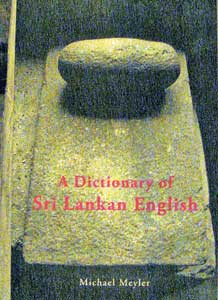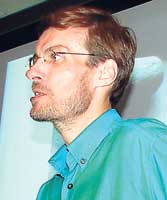
This is the way we speak English no!“What’s the difference between samba, sambur, sambhur and sambol? A molgaha and a miris gala? Malu miris and miris malu? A mudalali and a mudaliyar?” I’m only on the jacket blurb of Michael Meyler’s ‘A Dictionary of Sri Lankan English’, and I can already tell that it is going to be the best kind of educational experience. In fact, if I read his dictionary from cover to cover, I should be able to provide satisfactory answers to where you could find a floor patient, a cake structure, and an umbrella couple; I should be able to tell you what a soft corner is, what a dead rope is, and who would be deserving of the title ‘Forward Peter’. All these handy, heavily localised words and phrases are essential tools for the average Sri Lankan expressing himself or herself in English; so much so that very often you may not even be aware that you’ve adopted them. 22 years of living in this country, has given Michael – a lexicographer and teacher of both English and basic Sinhala – an interesting perspective on the use of English in the island. As an “informed outsider” living among us, Michael has been able to “chart the social and cultural nuances of the words and phrases that we use, nuances that we as Sri Lankans are scarcely aware of,” notes Prof. Rhyana Raheem in her introduction to the book.
Michael himself keeps things simple with his definition of Sri Lankan English (SLE). He says, “Sri Lankan English is the language spoken and understood by those Sri Lankans who speak English as their first language, and/or who are bilingual in English, Sinhala or Tamil.” While Michael himself ruefully admits to obvious inadequacies in his knowledge of Sinhala, his is a practical approach to the language. Street talk, with its blend of languages, colloquialisms, allusions to current events and constant transformations, is his arena, and his offering is a reflection of this. The dictionary, which is the first of its kind, began in the late 1980’s with few words jotted down on the back of an envelope, the result of his fascination with the way “English is spoken and written here.” When he ran out of space, Michael copied out his collection, and then as it grew, began to type lists of words, he says. Today, this manuscript has swelled to include over 2,500 examples of words and expressions which are characteristic of spoken English in Sri Lanka. Many of these words may be unique to this country - “kendirify” (a word of Sinhala origins, which means to complain or grumble) is an example – while others, like “by-heart,” (as in “we had to by-heart the whole poem”) are commonly used in other countries like neighbouring India. Many of the words that Michael picked up in the beginning were initially discovered in conversations with his friends. By the time the manuscript had begun to take shape, however, he had begun to cast his net further afield, drawing in data on the use of English in newspapers, magazines, advertisements, radio, conversations and more recently in books. He found that SLE included many non-English words. While a majority of these had their roots in Sinhala, there were many others which could be attributed to Tamil, and a smaller number that were derived from Dutch, Portuguese, Malay, Arabic, and Hindi, among other Indian languages. The borders that divide languages are incredibly porous, or so it seems. English words like “shape” will cross over with impunity, adopting new identities in Sinhala, only to sneak back across the border, hauling their new meanings with them. In other cases, non-English words are anglicised by the addition of an English ending ( as in ‘rasthiyadufy’), nouns becomes verbs (as in ‘horn’), articles get abandoned by the wayside, sentences bend and twist to accommodate new syntax (“They anyway won’t come”) and non-standard collocations or combinations of words settle in with the grim determination of illegal immigrants. Speaking with appreciation, Michael points out that in addition to such features, Sri Lankan English often cuts right through the idiosyncrasies of British English for a more streamlined, whittled down form of communication. Case in point: instead of the three words it takes to “toot your horn” or “sound your horn” many locals will simply say “horn”. In addition, when a speaker responds to a question like “can you come to my house afterward?” with a monosyllabic “can” or a double “can, can,” his or her brevity may be the result of the transfer of Sinhala or Tamil grammar or phrasing to spoken English. While some of these adaptations would be considered incorrect by strict advocates of British English, Prof. Dushyanthi Mendis explains that space must be made for this sub-category of English. “This dictionary, with its definitions, descriptions and examples serves two very important functions in my mind. First, I see it as a significant move towards obtaining international recognition for SLE as a distinct South Asian variety. Secondly, and more importantly, I hope that it will contribute towards the process of acceptance - within ourselves - of the existence of SLE,” she said.
Michael succeeds in adding to this desired credibility when he ropes in quotations from 30 books by authors like Shyam Selvadurai, Karen Roberts, Carl Muller, and Ameena Hussein to illustrate the nitty-gritty of such usage. Under each entry in the dictionary, a reader will also find a pronunciation guide, the derivation of the word, cross references to other entries, as well as notes comparing Sri Lankan and British usage. So when you consider that even aside from its name, the book gives every appearance of being a dictionary, it seems a little unexpected that Michael himself is not particularly keen on categorising it as precisely that. He emphasises that the dictionary is an attempt to describe the use of English in this country, rather than to prescribe the correct usage, or even to assign static meanings to locally used words and phrases. Pointing out that the language itself remains fluid and evolving, Michael adds that while the dictionary may make for a good beginning, there are several controversial, complex issues that must also be considered; the dictionary cannot be considered definitive. Sri Lankan English itself is a constantly evolving entity, affected greatly by several factors, including the popular influences, socio-economic backgrounds, schools of religious belief and the racial lineage its speakers claim. In spite of the obvious truth of this, in reading the dictionary, it is impossible not to enjoy and learn from the delightful quirks, and clever adaptations of SLE. As Michael himself notes, they serve to “greatly enrich the language, helping to relieve the drudge of a lexicographer’s toil, and hopefully entertain the curious reader.” |
|| Front
Page | News | Editorial | Columns | Sports | Plus | Financial
Times | International | Mirror | TV
Times | Funday
Times || |
| |
Reproduction of articles permitted when used without any alterations to contents and the source. |
© Copyright
2007 | Wijeya
Newspapers Ltd.Colombo. Sri Lanka. All Rights Reserved. |

